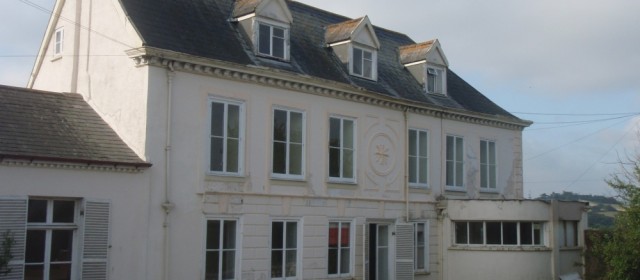Oakford Archaeology have undertaken a community evaluation, funded through the Dartmoor National Park Authority Moor than meets the Eye project, on the site of a suspected medieval manor house at Widecombe-in-the-Moor, Devon since 2012. As part of the community involvement the Oakford Archaeology field archaeologists undertaking the work have supervised up to thirty volunteers each day, in addition to providing guided tours of the...
Read MoreFollowing the discovery of three grave slabs during the installation of a new under-floor heating system at the Grade I listed church of St Peter’s, West Knighton, Dorset, Oakford Archaeology were commissioned by Mark Richmond Architects and Sally Strachey Historic Conservation to record the finds. The site visit recorded two previously unrecorded brass indents on a single slab of purbeck marble located in the south chapel. Although...
Read MoreIn early 2015 Oakford Archaeology was commissioned to undertake an archaeological watching brief on a small housing development at No. 4 Northcote Lane, Honiton, Devon. The site was located on the northern edge of the historic town. Little is known of Honiton prior to the Saxon period when it probably formed part of a great estate centred on Axminster. It isn’t until the early 13th century that a new borough was founded by William de...
Read MoreIn 2012 Oakford Archaeology was commissioned to undertake an archaeological watching brief at Heath Cottage, a grade II Listed building in Bridford, Devon, dating to the 17th century. The removal of concrete floors exposed elements of an earlier cobbled surface in the cross passage and the corridor leading to the parlour. Further areas of cobbled surface survived in the present toilet, while some cobbling survived in the living room...
Read MoreDuring the summer of 2014 Oakford Archaeology investigated a 17th century barn within the core of the historic town of Topsham, Devon. The building recording and investigations were intended to record and analyse the building and assess its significance. The barn was probably first constructed in the early 17th century as a threshing barn with opposed doorways, subsequently undergoing a number of renovations and alterations. The most...
Read MoreHistorical building recording was undertaken between March and May 2014 by Oakford Archaeology at No 52 Northernhay Street, Exeter, in response to the redevelopment of the property. The city Wall was originally built in the 2nd century AD to enclose the civitas of Isca Dumnoniorum. It was added to and maintained as a defensive enclosure for the city throughout the Middle Ages, and until the late 17th century was intermittently used...
Read MoreDuring the summer of 2013 Oakford Archaeology investigated a late 17th century country house within the core of the historic hamlet of Countess Wear, Exeter, Devon. The Investigation was intended to record and analyse the various buildings, and assess their significance. Mount Wear House is an important historic farmstead within the Countess Wear area, its size reflecting a large and prosperous farming establishment. The layout of the...
Read MoreIn 2011 DAK Properties engaged Oakford Archaeology to undertake an assessment and historic building recording on the former Artful Dodger Public House, Exeter. The building had become unsafe and was scheduled to be demolished. The former Artful Dodger public house was one of a group of historic properties within the Red Cow area. The layout of the house perpetuates that of an earlier house, possibly of late 17th- or 18th-century date,...
Read MoreOakford Archaeology was commissioned in 2013 by John Scott Architects and the Trusham Parochial Church Council to undertake an archaeological excavation at St Michael’s, near Newton Abbot, Devon. The works provided an incredibly rare opportunity to expose almost the entire interior floor plan of the church, exposing graves and vaults of medieval and post-medieval date. Interestingly no evidence was found of building activity...
Read MoreIn 2014 Oakford Archaeology was commissioned to undertake a staged programme of archaeological work, consisting of a desk-based assessment, geophysical survey and evaluation at Wessex Close, Topsham, Devon. The desk-based assessment highlighted that the site was located in an area of intense prehistoric and Roman activity, while the geophysical survey identified a number of linear and discrete anomalies. The subsequent evaluation...
Read More










Recent Comments